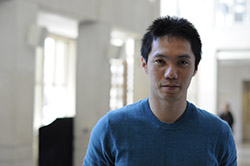
Autism spectrum disorders (ASDs) are a group of highly heritable neurodevelopmental disorders characterized by repetitive behaviors and problems with social interaction and communication. Ruoqi Gao, a fourth-year Medical Scientist Training Program student, has an interest in the genetics behind these conditions.
“ASDs are highly heritable disorders, meaning genetic mutations play an important role in their pathogeneses. Studying these mutations is like looking at the blueprints for a faulty building: they can give you clues on why the structure is unstable,” he said. “The molecular underpinnings of ASD are currently not well understood. As a result, not many effective pharmacological therapies exist. Consequently, our basic science work may spearhead more efficient treatments that improve clinical outcomes.”
Genetic studies of ASD patients consistently reveal mutations in genes responsible for dendrite development and patterning. Dendrites are tree-like projections of a neuron that receive signals from other nerve cells; their size and shape determine the number and distribution of a neuron’s synaptic contacts. As a result, dendrite morphological patterns are carefully regulated and can adaptively change as we age, learn or develop memories. Thus, defective dendrite development may be an important player in the disease process.
“Mutations of specific genes may cause problems with dendrite development” Gao said. “As a result, individual neurons may not communicate effectively with one another, leading to malfunctioning circuits that could ultimately eventually affect cognitive function.”
As a graduate student in the lab of Peter Penzes, PhD, Gao is interested in the mechanisms of dendrite arborization and how certain autism risk genes affect this process. Using neuronal cultures, biochemical techniques and state-of-the-art imaging, Gao manipulates the expression of particular genes in neurons and analyzes how and why these changes influence dendrite shape and branching patterns.
More specifically, Gao is interested in the dendrite arborization patterns of inhibitory neurons – a subset of neuronal cells that control how fast the excitatory neurons “fire” and transmit information.
“I think this particular focus is important because if inhibitory cells don’t do their jobs, then the excitatory cells will fire randomly. This can interfere with the synchronous transfer of information between brain regions and may even lead to epilepsy. Interesting, a third of autistic patients have epilepsy,” Gao said.






